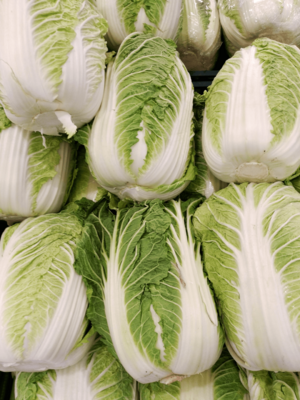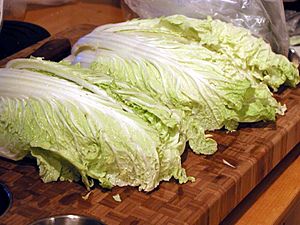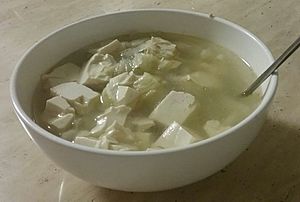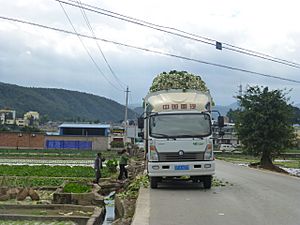Napa cabbage facts for kids
Quick facts for kids Napa cabbage |
|
|---|---|
 |
|
| Species | Brassica rapa |
| Cultivar group | Pekinensis Group |
| Origin | China, before the 15th century |
Napa cabbage is a type of Chinese cabbage that first grew near Beijing, China. It is super popular in East Asian cooking. Since the 1900s, it has also become a common crop in Europe, the Americas, and Australia. Many people around the world just call it "Chinese cabbage." In Australia, it's sometimes known as "wombok."
Contents
Names for Napa Cabbage
| Regional names | |
|---|---|

Napa cabbages
|
|
| Chinese name | |
| Chinese | 大白菜 |
| Literal meaning | big white vegetable |
| Hanyu Pinyin | dàbáicài |
| Wade–Giles | ta4-pai2-ts'ai4 |
| Cantonese name | |
| Traditional Chinese | 紹菜 |
| Yale Romanization | siuh choi |
| Jyutping | siu6 coi3 |
| Korean name | |
| Hangul | 배추 |
| Revised Romanization | baechu |
| McCune–Reischauer | paech'u |
| Japanese name | |
| Kanji | 白菜 |
| Hiragana | はくさい |
| Revised Hepburn | hakusai |
The word "napa" in "napa cabbage" comes from a Japanese word, nappa. This word means the leaves of any vegetable used for food. The Japanese name for this specific cabbage is hakusai (白菜). This comes from the Chinese name (白菜), which means "white vegetable."
In Korea, it's called baechu (배추). In Mandarin Chinese, it's known as dàbáicài (大白菜), meaning "big white vegetable." This helps tell it apart from "small white vegetable," which is known as bok choy. Other names for napa cabbage include Chihili or Michihili.
Outside of Asia, this vegetable is also called Chinese cabbage or sometimes celery cabbage. In Australia, it's often called wombok. In the United Kingdom, it's known as Chinese leaf or winter cabbage. In the Philippines, it's called petsay or pechay baguio. In Russia, it's pekinskaya kapusta (пекинская капуsta), meaning "Beijing cabbage."
Where Napa Cabbage Comes From
Napa cabbage was first grown in the 1400s near the Yangtze River in China. From there, it traveled to Korea and Japan. In the 1800s, as Chinese people moved to other parts of the world, napa cabbage spread to the rest of Asia, Europe, America, and Australia.
It might have come from a natural mix between the turnip (Brassica rapa subsp. rapa) and pak-choi (Brassica rapa subsp. chinensis). Scientists have done experiments that support this idea. Today, napa cabbage is grown and eaten all over the world.
What Napa Cabbage Looks Like
The part of the napa cabbage we eat is its leaves. These leaves grow tightly together, forming an oval shape. They are light green with white veins and feel smooth. A single napa cabbage can weigh between 1 to 3 kg (2.2 to 6.6 lb).
Napa cabbage is an annual plant. This means it completes its whole life cycle in one year. Farmers usually harvest it before it flowers. If it gets too cold or the days get too long, the plant might start to flower too early.
Napa Cabbage as a Vegetable
| Nutritional value per 100 g (3.5 oz) | |
|---|---|
| Energy | 68 kJ (16 kcal) |
|
3.2 g
|
|
| Dietary fiber | 1.2 g |
|
0.2 g
|
|
|
Protein
|
1.2 g
|
| Vitamins | Quantity
%DV†
|
| Vitamin C |
33%
27 mg |
| Minerals | Quantity
%DV†
|
| Calcium |
8%
77 mg |
| Iron |
2%
0.31 mg |
| Magnesium |
4%
13 mg |
| Sodium |
1%
9 mg |
| †Percentages estimated using US recommendations for adults. | |
Napa cabbage grows best when the days are short and the weather is mild. It forms an oblong head with crinkly, thick, light-green leaves. The leaves in the very center are light yellow.
Napa cabbage belongs to the Brassicaceae family, also known as the mustard or cabbage family. It's related to other common vegetables like broccoli, bok choy, and cauliflower.
This vegetable is very popular in China, Japan, and Korea. In China, napa cabbage is a symbol of good luck and wealth. You can often see it in glass and porcelain art. The famous Jadeite Cabbage sculpture in Taiwan's National Palace Museum is a carving of a napa cabbage.
In Korean cuisine, napa cabbage is the main ingredient for baechu-kimchi, which is the most common type of kimchi. It's also eaten raw, wrapped around pork or oysters, often dipped in gochujang (a spicy paste). The tougher outer leaves are used in soups. You can also use it in stir-fries with things like tofu, mushrooms, and zucchini. It's also a favorite in hot pot meals.
Napa cabbage is rich in vitamin C (26 mg per 100g) and has a good amount of calcium (40 mg per 100g). It has a mild, pleasant taste.
Growing Napa Cabbage
Napa cabbage can be grown in many places around the world, but Asia is where it's most diverse.
Soil and Climate Needs
Napa cabbage grows best in soil that is loose and not too heavy. The soil should have a lot of organic matter and hold moisture well. It prefers a slightly acidic soil, with a pH between 6.0 and 6.2. If the soil isn't right, the plant might not get enough calcium or magnesium, which can cause problems with its quality.
This plant needs a lot of water throughout its growing period. Farmers often use irrigation systems, especially in warmer months. The most important time for water is when the head is forming. If it doesn't get enough water then, the leaves inside the head can die.
Napa cabbage likes cool temperatures. It can handle temperatures just below freezing for a short time, but not long, hard frosts. The best temperatures for growing are between 13 and 21 °C (55 and 70 °F), depending on the specific type of cabbage. If it gets too cold, the plant might flower too early.
Planting and Care
Napa cabbage seeds are very small. For large farms, it's a good idea to use disinfected seeds to prevent diseases. Seeds are usually planted about 1 to 2 cm (0.39 to 0.79 in) deep.
Sometimes, young plants are started in a greenhouse and then moved to the field after a few weeks. This can help them be ready for harvest sooner.
Napa cabbage needs a lot of nutrients from the soil. Farmers add fertilizers to make sure the plants get enough nitrogen, phosphorus, potassium, calcium, and magnesium. Weeds are controlled either by machines or special chemicals.
Harvesting and Storage
Napa cabbage is usually ready to harvest 8 to 12 weeks after planting. Most of the time, people harvest it by hand, cutting the plant about 2.5 cm (0.98 in) above the ground. To get the best quality, farmers often harvest the field several times.
Once harvested, napa cabbage can stay fresh for three to four months if stored in cool places at 0–1 °C (32–34 °F) with high humidity. A good harvest can yield about 4 to 5 kg of cabbage per square meter.
Breeding New Types
Scientists and farmers work to create new and better types of napa cabbage. One challenge is that napa cabbage doesn't always self-pollinate easily.
A lot of work has been done in Korea to breed napa cabbage. In the 21st century, over 880 different types were officially registered there! Breeding efforts started in Korea in 1906 to help with food shortages. The goal was to grow more cabbage and to be able to grow it all year round.
Scientists have developed types of napa cabbage that can handle both hot and cold temperatures. For example, a summer type called “Nae-Seo-beak-ro” was created in 1973. It could handle high heat and humidity and was resistant to some diseases. Later, a winter type called “Dong-Pung” was developed in 1992, which could resist cold temperatures. Thanks to this work, fresh napa cabbage can now be grown year-round in Korea.
Breeders also aim to create types that are resistant to pests and diseases. Some types are resistant to a virus called turnip mosaic virus.
Pests and Diseases of Napa Cabbage
Like all plants, napa cabbage can be affected by pests and diseases. These can be caused by tiny fungi, bacteria, or viruses, as well as insects and other small creatures.
Fungal Diseases
Some common fungal diseases include Alternaria diseases, which cause dark spots on the plant. These spread quickly in wet weather. Another is Anthracnose, which causes dry, pale spots. Black root and White leaf spot are also fungal problems. Yellows, or Fusarium wilt, can cause the lower leaves to turn yellow, especially in warm soil. Damping-Off affects young seedlings, making them collapse and die.
To prevent these, farmers often rotate crops (don't plant cabbage in the same spot every year), remove old plant parts, and use disease-free seeds.
Bacterial Diseases
Bacterial soft rot is a big problem, especially in warm, humid places. It causes the cabbage to rot. These bacteria can spread through water, insects, or farm equipment. Black rot is another important bacterial disease.
To avoid bacterial diseases, farmers try not to use too much nitrogen fertilizer and harvest the cabbage at the right time.
Viruses
Several viruses can infect napa cabbage, including Cucumber mosaic virus and Turnip mosaic virus. These can cause the leaves to look unhealthy or spotted.
Insect Pests
Many insects like to eat napa cabbage. These include:
- Large white butterflies and small white butterflies (their caterpillars eat the leaves)
- Cabbage root flies (their larvae attack the roots)
- Cabbage seed weevils
- Cabbage loopers
- Diamondback moths
- Aphids (tiny insects that suck plant juices)
- Cucumber beetles
- Stink bugs
- Vegetable weevils
- Mole crickets
- Cutworms
Other Pests
Aster yellows is a disease caused by a tiny organism called a phytoplasma. Nematodes are tiny worms in the soil that can damage plant roots and cause big losses in crops.
See also
 In Spanish: Col china para niños
In Spanish: Col china para niños



